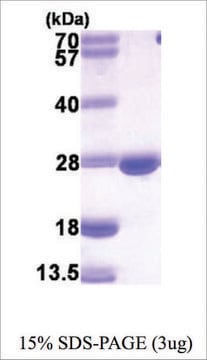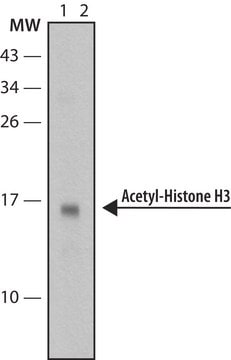EPI001
Histone Acetyltransferase (HAT) Activity Assay Kit
100 assays in 96 well plates
Synonyme(s) :
HAT Activity, Histone Acetyltransferase Activity
Se connecterpour consulter vos tarifs contractuels et ceux de votre entreprise/organisme
About This Item
Produits recommandés
Utilisation
100 assays in 96 well plates
Conditions d'expédition
wet ice
Température de stockage
−20°C
Description générale
Histone acetyltransferases (HATs) have critical roles in cellular functions and are involved in the regulation of gene transcription, differentiation, and proliferation. The HAT Activity Colorimetric Assay Kit offers a convenient, non-radioactive system for a rapid and sensitive detection of HAT activity in mammalian samples. The kit includes an active Nuclear Extract (NE) to be used as a positive control, HAT cofactor, acetyl-CoA, and all downstream cofactors and substrates. Acetylation of a peptide substrate by active HAT releases the free form of CoA, which then serves as an essential coenzyme for producing NADH. NADH can easily be detected spectrophotometrically upon reacting with a soluble tetrazolium dye. The detection can be continuous, and therefore, is suitable for kinetic studies. The kit provides all reagents and a simple, straightforward protocol for a complete assay.
Caractéristiques et avantages
- Sensitive and reliable assay
- Utilizes colorimetric methods
- Sample type: cell and tissue lysates
- Species reactivity: mammalian
- Suitable for individual tests or high throughput assays and kinetic studies
- Easy and simple procedure: combine nuclear extract or protein sample with reagents, incubate, and read absorbance
- Convenient 96-well microplate format
- Continuously measures HAT activity; suitable for kinetic studies
- No HDAC interference; crude nuclear extract can be used directly
Produit(s) apparenté(s)
Code de la classe de stockage
12 - Non Combustible Liquids
Certificats d'analyse (COA)
Recherchez un Certificats d'analyse (COA) en saisissant le numéro de lot du produit. Les numéros de lot figurent sur l'étiquette du produit après les mots "Lot" ou "Batch".
Déjà en possession de ce produit ?
Retrouvez la documentation relative aux produits que vous avez récemment achetés dans la Bibliothèque de documents.
Koji Maemura
Nihon rinsho. Japanese journal of clinical medicine, 71(12), 2124-2129 (2014-01-21)
Cardiovascular function exhibits circadian oscillation. Furthermore, the onset time and severity of cardiovascular diseases exhibit diurnal variation. The internal circadian clock whose center exists in the suprachiasmatic nucleus regulates this circadian variation. Many studies have reported that night shift workers
Hiroshi Watanabe et al.
Nihon rinsho. Japanese journal of clinical medicine, 71(12), 2091-2096 (2014-01-21)
Aging alters a broad spectrum of physiological, endocrine, and behavioral rhythms, and the close relationship between age-associated disease and disrupted circadian rhythms has been shown. Circadian rhythms are regulated by a set of clock genes and mutations in clock genes
Igor Efimov et al.
FEBS letters, 588(5), 701-704 (2014-01-21)
We describe a simple method for the determination of heme protein reduction potentials. We use the method to determine the reduction potentials for the PAS-A domains of the regulatory heme proteins human NPAS2 (Em=-115 mV ± 2 mV, pH 7.0)
Michiko Konno
Nihon rinsho. Japanese journal of clinical medicine, 71(12), 2171-2178 (2014-01-21)
Mood disorders show a common feature of distorted cycling of biological systems, manifesting, for example, as diurnal mood variation in depression, phasic time course in bipolar disorder, and seasonal mood swing in seasonal affective disorder. Accordingly, circadian dysfunction has been
Sydney P Thomas et al.
eLife, 10 (2021-10-23)
Short-chain fatty acids (SCFAs) acetate, propionate, and butyrate are produced in large quantities by the gut microbiome and contribute to a wide array of physiological processes. While the underlying mechanisms are largely unknown, many effects of SCFAs have been traced
Notre équipe de scientifiques dispose d'une expérience dans tous les secteurs de la recherche, notamment en sciences de la vie, science des matériaux, synthèse chimique, chromatographie, analyse et dans de nombreux autres domaines..
Contacter notre Service technique








